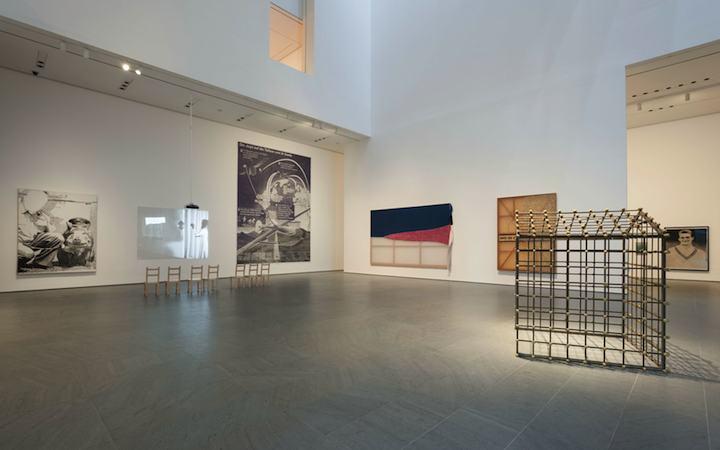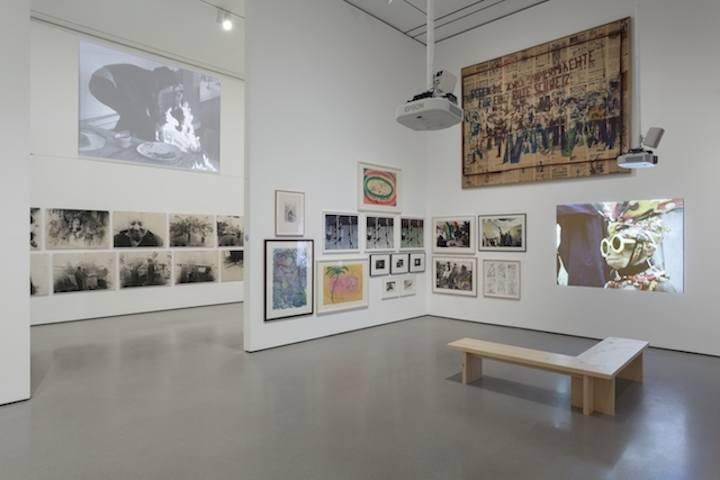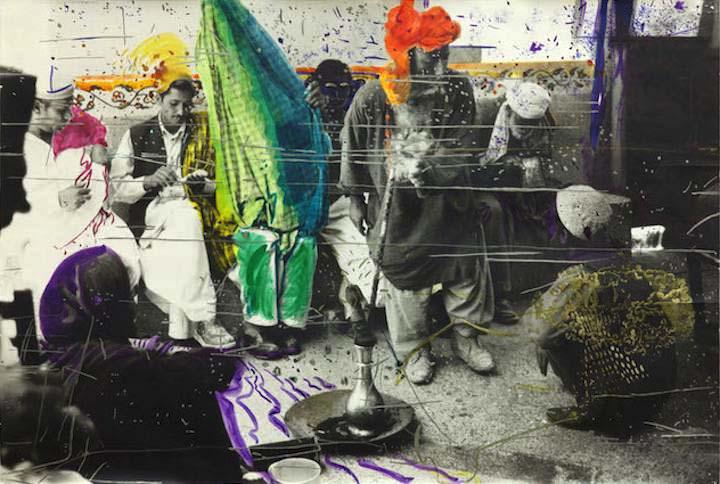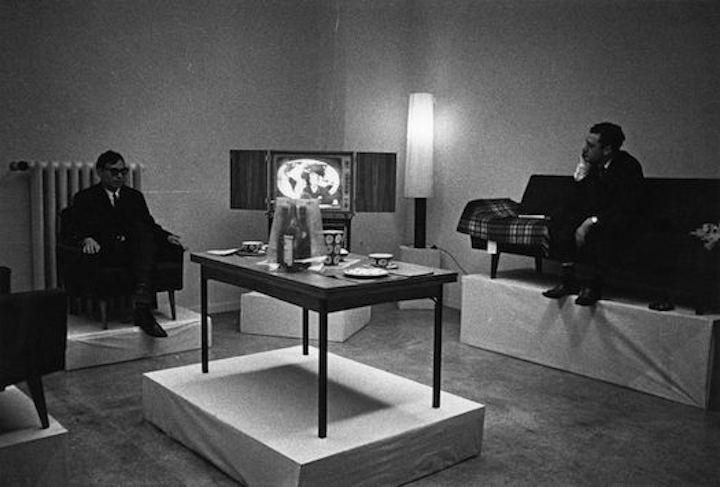Sigmar Polke: NYCx2
Until August 3, New Yorkers and visitors have a rare opportunity to immerse themselves in the electrifying art of Sigmar Polke. Taking on distinctions between appearance and reality as
a base line, this voraciously experimental artist blurred existing boundaries between high and low culture, figuration and abstraction, appearance and reality.
Sigmar Polke (1963-2010) is
the subject of a major retrospective on view at MoMA, in which this protean artist, who produced works across a broad range of mediums, is revealed through 265 pieces whose cumulative effect will
surely help to submerge the current trend that celebrates commodified art made for sale at art fairs.
Seemingly informed by a raucous wit and intelligence, the work is grounded in the
artist's enduring skepticism of authority, at every level of society. Polke moved through painting and drawing to photography, collage, filmmaking, and graphics in giant strides, blending various
means in ways previously unseen, to shape a trenchant commentary informed by Germany's post-war politics of forgetfulness.

His work was highly experimental, starting with projects influenced by parapsychology and
mind-expanding substances in the 1960s. Through interventions such as these, often employing non-art materials that included pine pitch and bubble wrap, for example, he reinvented his thought and
process.
Later on his experimental use of materials expanded to include toxic substances, such as uranium and other heavy metals. He constantly risked artistic "success," not to mention
his health, often combining materials that would destabilize his images, some of which would undergo alterations beyond his control simply through interactions between the artworks and the air
surrounding them. Construction and destruction, not much in balance, were engines that fueled his ceaseless production.
In the 1970s, Polke embarked on serial travels to unexpected places, from Bali to Afghanistan to New Guinea, Sri Lanka, the United Arab Emirates, China and all across Europe. Taking film and camera, he made photographs that later surfaced as images he reworked in the studio. Once, according to the catalogue, he drifted away on a hash tour that resulted in a bouquet of peacock feathers he tacked onto the wall. Polke engaged in practices that promised psychedelic experiences or expanded consciousness; interactions such as these were later called “technologies of the self” by Michel Foucault.

That is just the beginning of Polke’s five-decade-long quest to make art through which he resisted the gravitational pull of the known and the codified. Instead he strove to demonstrate how the unconscious, in combination with other forms of knowledge, casts its shadow on how the imagination might be set free. By letting go of certainty, embracing the ambiguous, he dared to shape an ethos, a vision through which he could operate within—and thereby present—the immaterial. Through these explorations, he created an art form that has been called “unstable,” “layered,” “contingent,” “inconsistent,” “coincident,” and “dissolving.”
The influence of Polke seems to continuously expand rather than to retreat—and will likely accelerate, given this exhibition,
which will next be seen at the Tate Modern, opening in October. Notoriously reticent about his thought and process during his lifetime, his attitude might have been, “If you are here
you’re probably smart enough to figure this out.” In a sense, he directed the headlamps onto the eyes of his viewers, causing them to reel uncertainly before his ever-shifting
manifestations.
The exhibition at MoMA, which has excellent wall texts introducing the each of the five galleries comprising the show eschewed labels explaining individual
works—perhaps an overt homage to the artist's reticence. Instead there is a printed guide that also includes the wall texts, leaving mental space for visitors to shape their own ideas about what
they see and experience in this mind-bending show. This is a welcome shift for MoMA, and one that underscores the confidence of the curator, Kathy Halbreich.
 Sigmar Sigmar Polke, “Untitled (Quetta, Pakistan)” (1974/1978). Photo: Alex
Jamison/Hypoallergenic
Sigmar Sigmar Polke, “Untitled (Quetta, Pakistan)” (1974/1978). Photo: Alex
Jamison/Hypoallergenic
“Some day we shall no longer need pictures,” Polke wrote: “we shall just be happy. For we shall know what eternity is, and our knowledge will make us happy. Life after death will be explored and will set us an example of new modes of conduct.”
Alibis: Sigmar Polke (1963-2010), closes at MoMa on August 3. 11 West
53rd Street, NY, NY. Information. The catalogue of "Alibis: Sigmar Polke,
1963-2010,
prepared by the Museum of Modern Art in New York and the Tate Modern in London, includes numerous scholarly essays by art historians and curators along with illuminating
appreciations by artists. Information.
Installation views (row 1 and 2 above) of “Alibis: Sigmar Polke 1963–2010″, © 2014 The Museum of Modern Art. Images Courtesy of The Museum of Modern Art. Photographs by Jonathan Muzikar. Works by Sigmar Polke © 2014 The Estate of Sigmar Polke/Artists Rights Society (ARS), New York/VG Bild-Kunst, Bonn, Germany

Living with
Pop – A Demonstration for Capitalist Realism, 1963. © 2014 Artists Rights Society (ARS), New York / VG Bild-Kunst, Bonn. Photo: Reiner Ruthenbeck
Continuing at Artists Space through August 17 is a revisitation of the 1963 Düsseldorf exhibition, Living with Pop, a show that launched the careers of four artists engaged in art they named “Capital Realism.” Of the four, only Gerhard Richter and Sigmar Polke went on to carve their names into a previously monolithic European art scene. The show makes clear that Polke and Richter drew their early inspiration as much from the anarchic, anti-art actions of Fluxus as from the pictorial strategies of American Pop art, a fact easily forgotten in the celebration of Polke and Richter as "great painters."
The show highlights the career-long preoccupations of these two artists gathering the contents of their work from self-reproduced materials. By relying on documentation and reproduction, the show proposes to “approach the original gesture” of the Capital Realist artists. In addition, the website, based on the original exhibition materials shown earlier this year at Kunsthalle Düsseldorf, presents an in-depth survey of contemporaneous art events and practices.
Living with Pop: A Reproductionof Capitalistic Realism continues at Artists Space through August 17. 38 Greene Street, NY, NY. Information. The 314-page bilingual catalogue for "Living with Pop: A Reproduction of Capitalist Realism," provides analysis and documentation of Polke's early years.





